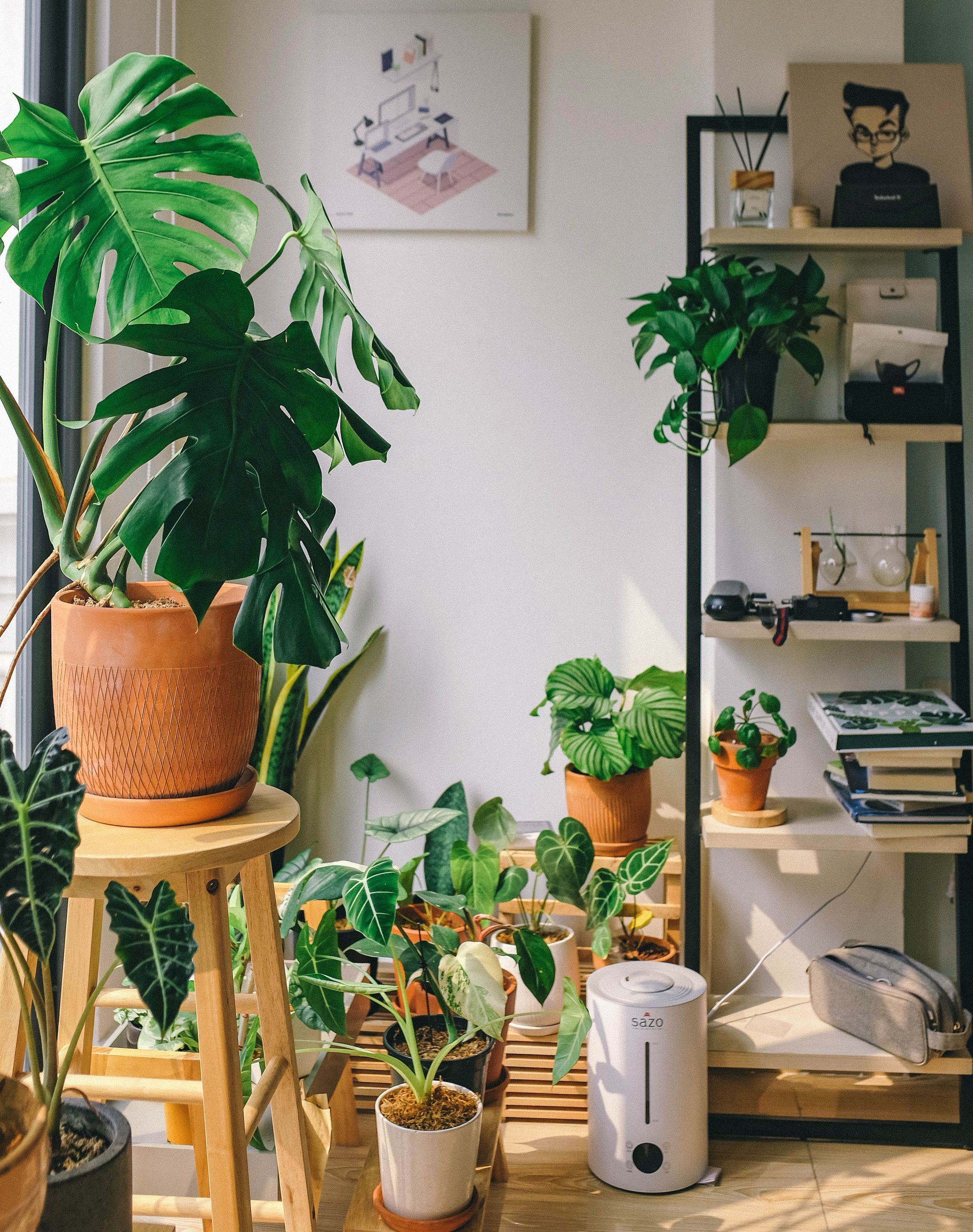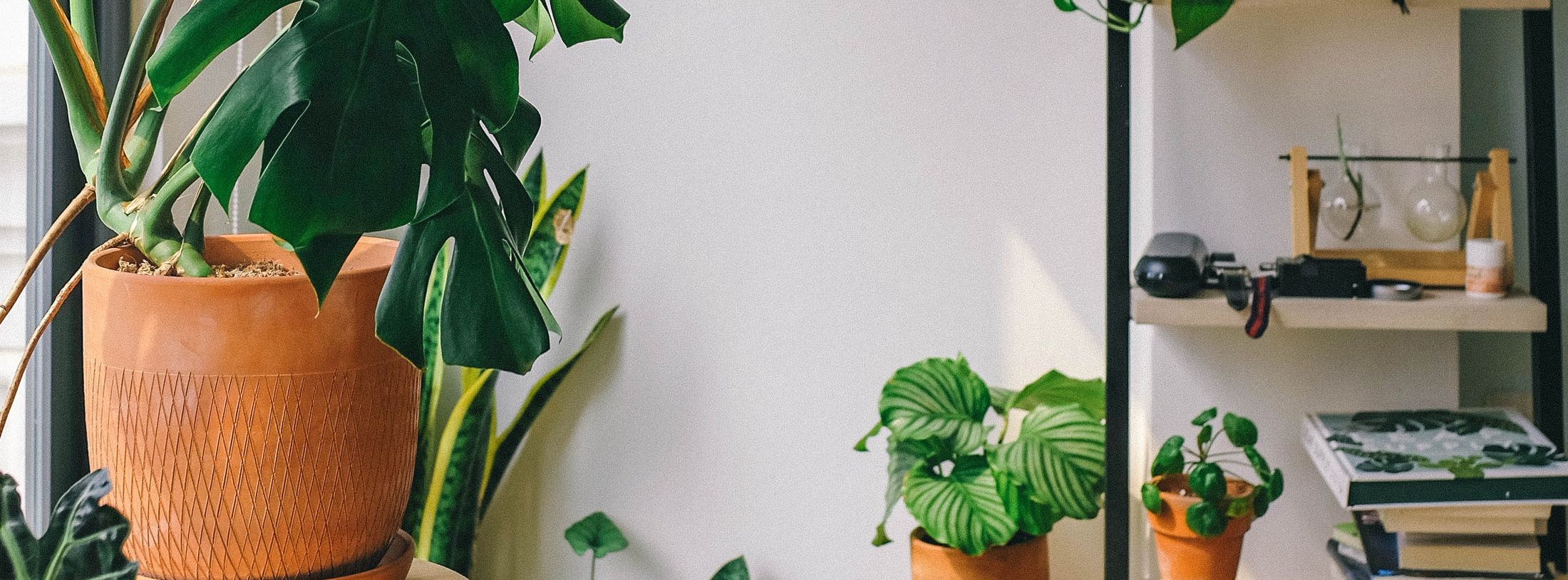In a world full of smoke, smog, and acid rain, we also have the humble houseplant. For those with a living space full of priceless leafy plant babies, these tiny (but mighty) indoor plants are often a fun way to brighten up a room, and research shows they may even help with focus and productivityOpens in a new tab.. But what if we told you there's much more to these plants than meets the eye?
While beautiful to look at and fun to care for, houseplants are becoming increasingly popular in the battle against air pollution. But what do the experts have to say, and can common houseplants really influence the air quality in an indoor environment?
Let's find out.
What Affects Indoor Air Quality?
Did you know that indoor air pollution is one of the world's most significant environmental health riskOpens in a new tab.?
According to the U.S. EPA (Environmental Protection Agency), the levels of indoor air pollutants are sometimes up to five times greater than outdoor levels. This isn't good by any means, especially as the average American spends around 90 percent of their timeOpens in a new tab. snugly indoors.
So, what contributes to poor indoor air quality? Although many factors can contribute to unhealthy air (think: dust, dander, poor ventilation, etc.), the culprit that’s the most difficult to combat are VOCs.
What Are VOCs?
Volatile organic compounds, or VOCs for short, are a class of harmful chemicals that can be "off-gassed" — or emitted as vapors — in the air we breathe. They can be found in many common household products and building materials,Opens in a new tab. including:
- Paints
- Cleaners
- Disinfectants
- Air fresheners
- Glues
- Flooring
- Permanent markers
- Upholstery
- Pesticides
- Furnishings
- Cooking activities
- Beauty products such as fragrances
VOCs might be invisible to the naked eye, but the concentrations of these silent killers are consistently higher in indoor spaces than in outdoor air, and their impacts pose very tangible consequences.
Studies reveal breathing in low levels of VOCs over long periods of time may increase the chance of developing certain health problemsOpens in a new tab., such as asthma, allergies, and even different types of cancer. But you don't need years of exposure for these toxic gasses to begin wreaking havoc on your health.
According to experts, some people experience headaches, dizziness, and even memory impairment almost immediately after coming into contact with VOCsOpens in a new tab..
Of course, everyone is different, so reactions can vary from person to person. Some folks are also more susceptible than others — but if there's one thing that's for certain, it's that these pollutants can be especially damaging to one's health.
Can Air Purifiers Improve Indoor Air Quality?
Yes, air purifiers can improve indoor air quality, but there are limits to what these machines can achieve. The bottom line is that air purifiers made with HEPA filters, which accounts for most air purifiers, don’t capture VOCs — which are some of the most prominent indoor air pollutants.
Even further, air purifiers that do claim to remove VOCs use one of four technologiesOpens in a new tab., all of which have drawbacks:
- Catalytic oxidation technology, which can sometimes generate harmful byproducts like formaldehyde (Dhada, Sharmar, and Nagar, 2016)
- Plasma, which can also generate harmful byproducts such as carbon monoxide, ozone, and formaldehyde (Harriman, Stephens, and Brennan, 2019)
- Ozone generation, which has yet to be approved by any federal agency for use in occupied spaces (Hubbard, Coleman, Sarwar, and Corsi, 2005)
- Adsorbent media, which generally entails the use of activated carbon that is easily saturated and can end up releasing pollutants back into the air if filters aren’t changed (Sparks and Chase, 2016)
Moreover, concerns have been brought to the forefront about some types of air purifiers that produce ozone — a toxic gas that is especially harmful to the planet.
Air purifiers known as "ozone generators" and those that use photocatalytic oxidation can create this toxic gas, which may react with some pollutants in a way that can make indoor air worse off than where it started.
In addition to not being great for the environment byproduct-wise, air purifiers also require constant maintenance with filter replacement, which is another point against not meeting the sustainability mark. Not to mention the vast consumption of electricity that comes as a result of air purification devices — especially if you leave them running long enough for them to make a real difference.
Can a Regular Houseplant Influence Indoor Air Quality?
Plants are indispensable to human life. Different plants convert the carbon dioxide (CO2) we exhale into fresh oxygen, and even help remove health-damaging toxins from the air we breathe. But we'll be honest — it's way too inefficient for a real impact on air qualityOpens in a new tab. when we’re talking about the handful of potted plants inside the average home.
A NASA research project investigated biological life support systems for space travel — and the results of the project indicated that various plants have a compelling ability to remove VOCs from the air. Naturally, this sparked the idea that potted plants can positive impact indoor air quality.
There is indeed a well-documented ability for plants to take up VOCs in lab studies, but the real truth is that these studies simply aren’t accurate representations of conventional living areas, like bedrooms. As such, the effectiveness of a potted plant to clean indoor airOpens in a new tab. in more complex environments is still a bit of a grey area.
When it comes down to it, it would take dozens of conventional, potted houseplants to have a notable impact on the air quality in a single room. And this just isn’t practical.
That’s why we created Neo P1Opens in a new tab., the first air-purifying plant bioengineered to clean the air in your home from the most harmful VOCs up to 30 times better than regular plant species.
So, while a regular houseplant may not bring you the clean air you're after, Neo P1 can. And what better way to improve indoor air quality than with a kickass plant that's both beautiful and effective?
All of this said, we do still love regular houseplants for other reasons, and you can, too. After all, studies show that houseplants can have positive effects on human mental healthOpens in a new tab., and what’s not to love about that?
Bioengineered Houseplants: What You Need To Know
The average houseplant does very little to clean the airOpens in a new tab. in our homes.
Bioengineered houseplants created by yours truly here at Neoplants, however, are up to 30 times better than regular plants when it comes to air purification. And unlike regular houseplants that can actually store pollutants, Neo P1 recycles them into useful metabolites like sugars and amino acids, the building blocks of plant cells.
Here at NeoplantsOpens in a new tab., we're on a mission to put Mother Nature at the heart of innovation to drive positive change — that's why we've built the first generation of bioengineered plants that fight air pollution.
How Do Bioengineered Plants Improve Air?
Most VOCs are tiny carbon-based molecules, making them extremely difficult to remove from the air with a mechanical filter. This is why plants have an advantage: plants love carbon! The only downside is that regular household plants only know how to use carbon dioxide (aka CO2) as a source of carbon, and therefore, are really inefficient at absorbing VOCs.
Neo P1Opens in a new tab., however, is specifically designed to target and eliminate VOCs (think formaldehyde, toluene, benzene, and xylene) with maximum efficiency and filtration power — no bulky air purifiers or filters required.
Good for the world, gorgeous for your home — this is a super plant with superpowers.
The Bottom Line: Neoplants Do What Regular Houseplants Can't
So, can a regular houseplant really influence air quality?
Yes, but it's way too inefficient to have any kind of real impact.
But don’t worry, this sentiment is what we’ve built our entire mission around, if you're on the same mission to use the power of plants to keep your indoor air clean, look no further than Neo P1 — the world's first bioengineered plant specifically designed to target and eliminate harmful VOCs so that you can breathe a little easier.
Ready to start working with nature and join us on our mission? Join our waitlist Opens in a new tab.to get first access to Neo P1.
Bibliography:
- Dhada, I, Sharma, M, Nagar, PK. Quantification and human health risk assessment of by-products of photo catalytic oxidation of ethylbenzene, xylene and toluene in indoor air of analytical laboratories. J Hazard Mater. 2016 Oct 5;316:1-10. doi: 10.1016/j.jhazmat.2016.04.079. Epub 2016 May 6. PMID: 27208611.
- Harriman, L., Stephens, B., and Brennan, T. New Guidance for Residential Air Cleaners. ASHRAE Journal. 2019 Sep.
- Hubbard HF, Coleman BK, Sarwar G, Corsi RL. Effects of an ozone-generating air purifier on indoor secondary particles in three residential dwellings. Indoor Air. 2005 Dec;15(6):432-44. doi: 10.1111/j.1600-0668.2005.00388.x. PMID: 16268833.
- Sparks T, Chase G. Air and Gas Filtration. Filters and Filtration Handbook. 2016:117–98. doi: 10.1016/B978-0-08-099396-6.00003-4. Epub 2016 Jan 29. PMCID: PMC7161406.
Other Sources:
- Early-Stage Emissions of Formaldehyde and Volatile Organic Compounds from Building Materials: Model Development, Evaluation, and Applications | Environmental Science & TechnologyOpens in a new tab.
Potted plants do not improve indoor air quality: a review and analysis of reported VOC removal efficiencies | Journal of Exposure Science & Environmental EpidemiologyOpens in a new tab. - Can ornamental potted plants remove volatile organic compounds from indoor air? A review | PubMedOpens in a new tab.
- Introduction to Indoor Air Quality | US EPAOpens in a new tab.
- Indoor Air Pollution | Our World in DataOpens in a new tab.
- Indoor Air Quality | US EPAOpens in a new tab.
- Volatile Organic Compounds in Your Home | MN Dept. of HealthOpens in a new tab.
- Volatile Organic Compounds' Impact on Indoor Air Quality | US EPAOpens in a new tab.
- Effects of Indoor Plants on Human Functions: A Systematic Review with Meta-Analyses | PMCOpens in a new tab.
- Potted plants do not improve indoor air quality: a review and analysis of reported VOC removal efficiencies | Journal of Exposure Science & Environmental EpidemiologyOpens in a new tab.
- Interaction with indoor plants may reduce psychological and physiological stress by suppressing autonomic nervous system activity in young adults: a randomized crossover study | PMCOpens in a new tab.
- Residential Air Cleaners - A Technical Summary | EPAOpens in a new tab.
- Quantification and human health risk assessment of by-products of photo catalytic oxidation of ethylbenzene, xylene and toluene in indoor air of analytical laboratories | NCBI Opens in a new tab.
- Effects of an ozone-generating air purifier on indoor secondary particles in three residential dwellings | NCBIOpens in a new tab.
- Air and Gas Filtration | PMCOpens in a new tab.
- New Guidance for Residential Air Cleaners | EPAOpens in a new tab.

